

Specify password to be added (legacy option, equivalent to −w) Specify label (if omitted, service name is used as default label) Specify generic attribute value (optional) Specify kind (default is "application password") Specify item type (optional four-character code) Specify item creator (optional four-character code) Specify an application which may access this key (multiple −T options are allowed)Īdd-generic-password Use the specified keychain rather than the defaultĪllow any application to access this key without warning (insecure, not recommended!) Make a key valid for the number of days specified from today Make a key valid from the specified date (ex: "13/11/10 3:30pm") Specify the keysize in bits (default 512) Use alg as the algorithm, can be rsa, dh, dsa or fee (default rsa) Interactive access control list editing modeĬreate-keypair New keychain password (if not provided, will prompt) Old keychain password (if not provided, will prompt) Set password for keychain, or the default keychain if none is specified. Specify timeout interval in seconds (omitting this option specifies "no timeout"). Set settings for keychain, or the default keychain if none is specified. Unlock keychain, or the default keychain if none is specified. If the −a option is specified, all keychains are locked. Lock keychain, or the default keychain if none is specified. If neither −P or −p password are specified, the user is prompted for a password on the command line. Use password as the password for the keychains being created. Prompt the user for a password using the SecurityAgent. Unset it if no keychain is specified.Ĭreate-keychain Set the login keychain to the specified keychain. Set the default keychain to the specified keychain. Set the search list to the specified keychains.ĭefault-keychain ] Here (finally) are details on all the security commands and the options each accepts. This option is essentially the same as the help command. Show a usage message for the specified command. This section describes the command_options that are available across all security commands. Make changes to the authorization policy database.Įnable, disable or list disabled smartcard tokens.ĭisplay a descriptive message for the given error code(s).
#Mac terminal commands security install
Install (or re-install) the MDS database.ĭisplay or manipulate user-level trust settings. Get the preferred identity to use for a service. Set the preferred identity to use for a service. Set the partition list of a internet password item.įind an identity (certificate + private key).ĭelete a certificate and its private key from a keychain. Set the partition list of a generic password item. Show all commands, or show usage for a command.ĭisplay or manipulate the keychain search list.ĭelete keychains and remove them from the search list.ĭump the contents of one or more keychains. Here are brief descriptions of all the security commands: However, you don’t have to master every detail for security to be useful to you. Security provides a rich variety of commands (Ĭommand in the SYNOPSIS ), each of which often has a wealth of options, to allow access to the broad functionality provided by the Security framework. This option implies the −i option but changes the default prompt to the argument specified instead. On itself to see if the command(s) you executed had any leaks. Security> by default ) will be displayed and the user will be able to type commands on stdin until an EOF is encountered. If arguments are provided, show usage for each the specified commands. If no arguments are specified, show a list of all commands. Here is a complete list of the options available: When EOF is read from stdin security will exit. If the −i or −p options are provided, security will enter interactive mode and allow the user to enter multiple commands on stdin. Security DescriptionĪ simple command line interface which lets you administer keychains, manipulate keys and certificates, and do just about anything the Security framework is capable of from the command line.īy default security will execute the command supplied and report if anything went wrong. Security - Command line interface to keychains and Security framework Synopsis


 0 kommentar(er)
0 kommentar(er)
